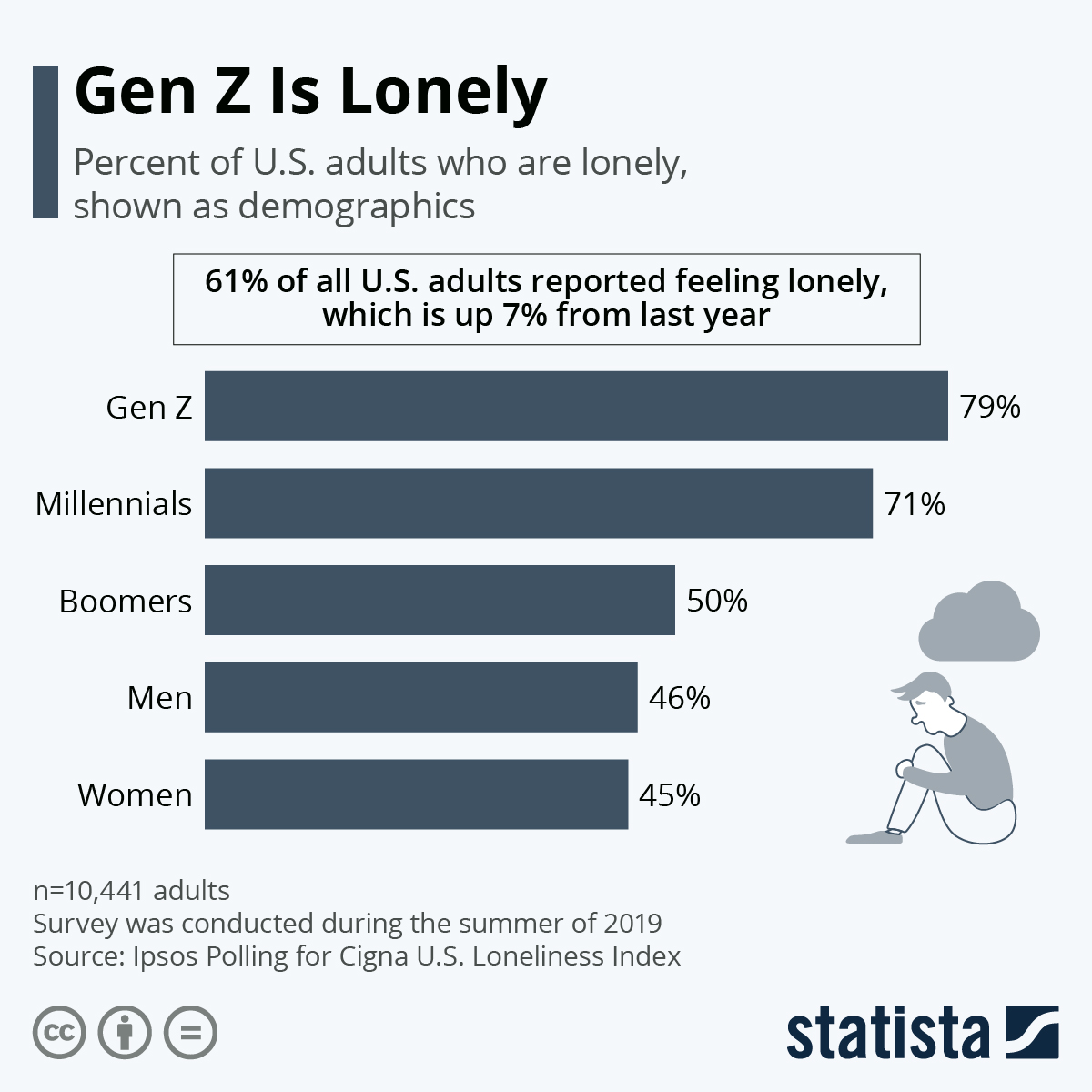Introduction
We live in the most connected era in history—constant messaging, liking, following, and group chats—yet studies show that many feel lonelier than ever. This paradox underscores that abundant digital contact does not equate to genuine human connection.
What Is Collective or “Extended” Loneliness?
Also known as “connected loneliness,” this phenomenon refers to feeling emotionally isolated while surrounded by superficial online interactions. Turkle (2011) coined the term “alone together” to describe people who are digitally tethered yet emotionally detached from real conversations and intimacy.
Read More- Loneliness and AI
The Loneliness Crisis
In November 2023, the World Health Organization (WHO) declared loneliness a global public health threat comparable to smoking or obesity. It is estimated that nearly 900,000 deaths annually can be attributed to its physiological consequences, such as cardiovascular disease, diabetes, and inflammation (World Health Organization, 2023).
In Australia, one in four young people report experiencing chronic loneliness, despite high digital engagement (News.com.au, 2023). Similarly, in the United States, more than half of adults report feeling lonely, prompting state-level initiatives like Connecticut’s “social prescribing” programs aimed at building community bonds (CT Insider, 2023).
U.S. Surgeon General Vivek Murthy and the Department of Health and Human Services have classified long-term loneliness as an epidemic requiring urgent national action (Murthy, 2023).
Why Hyperconnectivity Fails to Connect
-
Social Comparison and Curated Lives
Social media fosters comparison through curated highlight reels, often leading to feelings of envy and exclusion. Passive scrolling can increase emotional distance rather than foster closeness (SoBrief, 2023). -
Superficial Interactions
While texting and social media offer convenience, they often lack emotional depth. Repeated online interactions cannot replace meaningful face-to-face conversations (The New Yorker, 2023). -
Feedback Loop of Isolation
Studies suggest that loneliness leads to increased screen time, which in turn further deepens social disconnection, creating a self-reinforcing cycle (SoBrief, 2023).

Health Consequences
Chronic loneliness has been linked to heightened inflammation and elevated cortisol levels, increasing the risk for heart disease, type 2 diabetes, stroke, depression, and early mortality (News.com.au, 2023).
It undermines overall well-being and is now seen as a health risk on par with major medical conditions.

Bridging the Loneliness Gap
Reviving “Third Places”
Spaces like cafés, libraries, and community centers have historically served as informal social hubs. The decline of these spaces contributes to emotional isolation. Reinvestment in these environments can help restore organic human connection (Killam, 2023).
Social Prescribing
Health systems are increasingly recommending community engagement—volunteering, hobby groups, or counseling—as part of patient care. Connecticut’s Collaborative to End Loneliness is one such initiative showing early promise (CT Insider, 2023).
Intentional Tech Use
Encouraging meaningful digital interaction—such as video or voice communication—over passive scrolling can help foster emotional bonds rather than dilute them (Turkle, 2011).

Real-World Anecdotes and Initiatives
In Seoul, “mind convenience stores” offer mental wellness spaces for young people. These include peer counseling, board games, and food, designed to reduce stigma and encourage casual support networks. The initiative is part of a £242 million city-wide effort (The Guardian, 2023).
In the United States, Connecticut’s statewide campaign mobilizes schools, nonprofits, and healthcare providers to combat loneliness through inclusive programming and social prescriptions. More than 50% of residents report experiencing isolation (CT Insider, 2023).
Experts such as Killam (2023) advocate for integrating social connection into public health frameworks, recognizing its importance alongside physical exercise and nutrition.
Why This Matters
Loneliness is more than a personal issue—it is a societal crisis. It erodes empathy, weakens community trust, and contributes to polarization and social fragmentation, particularly among young people. Addressing loneliness enhances community resilience and strengthens civic and emotional health (Murthy, 2023).
How You Can Help
-
Prioritize face-to-face or voice interactions over passive digital engagement.
-
Support or create community spaces—sports clubs, local book circles, hobby groups.
-
Inquire about social prescribing programs through local clinics or workplaces.
-
Volunteer: helping others promotes purpose and belonging.
Conclusion
Yes, you can feel lonely in a room full of digital friends—and that’s okay. The solution is not in accumulating more contacts, but in cultivating deeper, more meaningful ones. Through authentic communication, community investment, and intentional interaction, we can move from being “alone together” to being truly together.
References
CT Insider. (2023). Connecticut’s Collaborative to End Loneliness. Retrieved from https://www.ctinsider.com
Killam, K. (2023). The Social Health Movement: Why Connection Matters. WIRED.
Murthy, V. H. (2023). Our Epidemic of Loneliness and Isolation: U.S. Surgeon General’s Advisory. U.S. Department of Health and Human Services.
News.com.au. (2023). Loneliness Crisis in Australia. Retrieved from https://www.news.com.au
SoBrief. (2023). How Social Media Deepens Loneliness. Retrieved from https://www.sobrief.com
The Guardian. (2023). Seoul’s Mental Health Convenience Stores. Retrieved from https://www.theguardian.com
The New Yorker. (2023). The Myth of Digital Intimacy. Retrieved from https://www.newyorker.com
Turkle, S. (2011). Alone Together: Why We Expect More from Technology and Less from Each Other. Basic Books.
World Health Organization. (2023). Loneliness as a Global Public Health Threat. Retrieved from https://www.who.int
Subscribe to PsychUniverse
Get the latest updates and insights.
Join 3,005 other subscribers!
Niwlikar, B. A. (2025, July 22). Loneliness in a Hyperconnected Work and 4 Important Reasons For It. PsychUniverse. https://psychuniverse.com/loneliness-in-a-hyperconnected-work/



